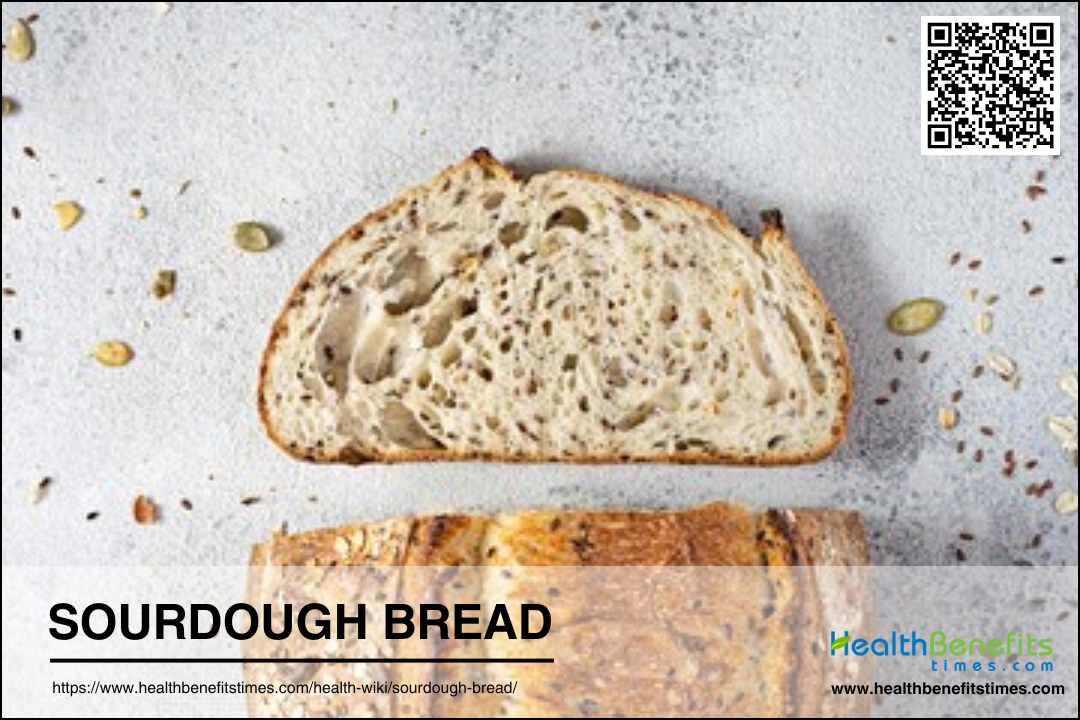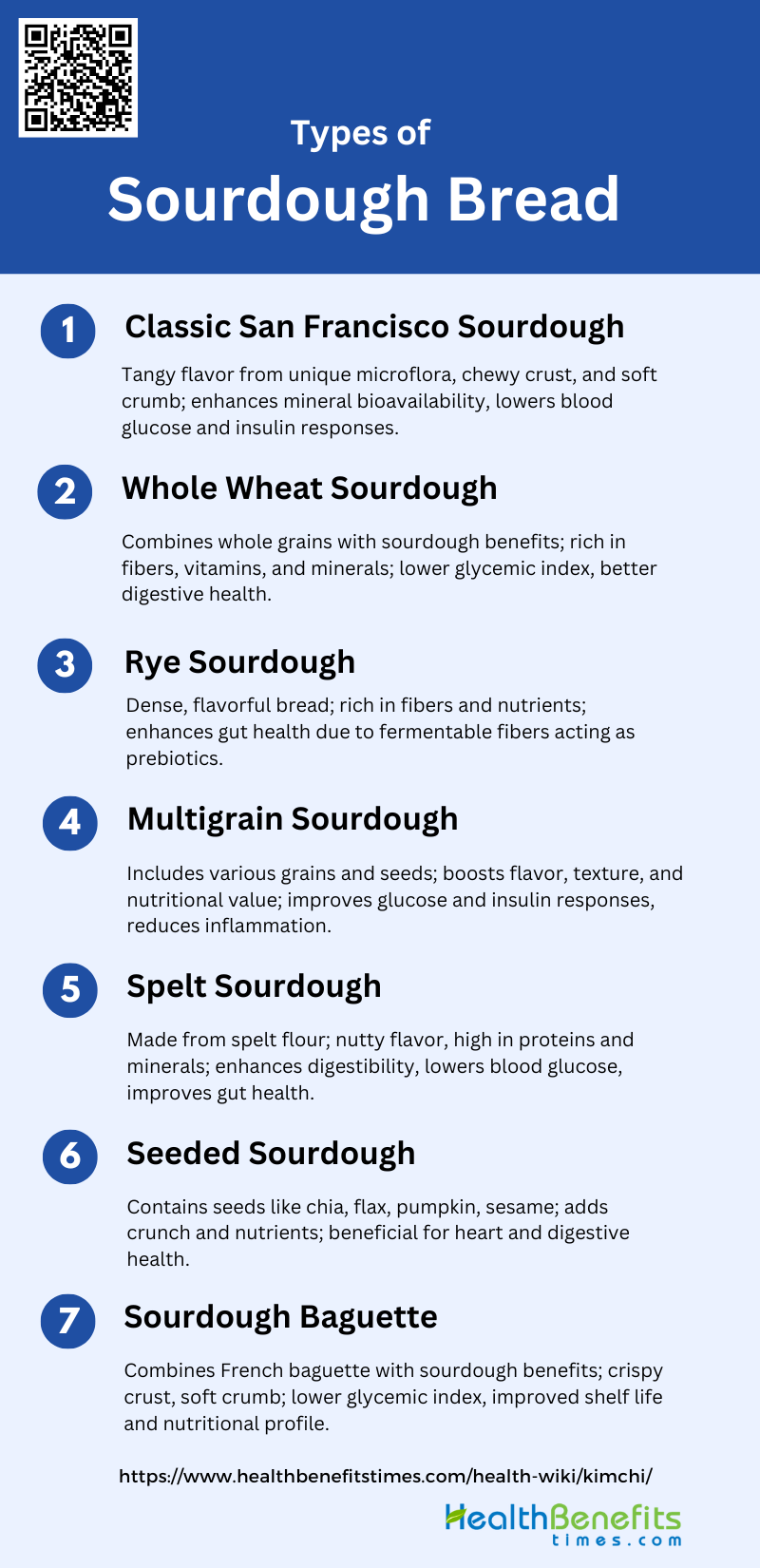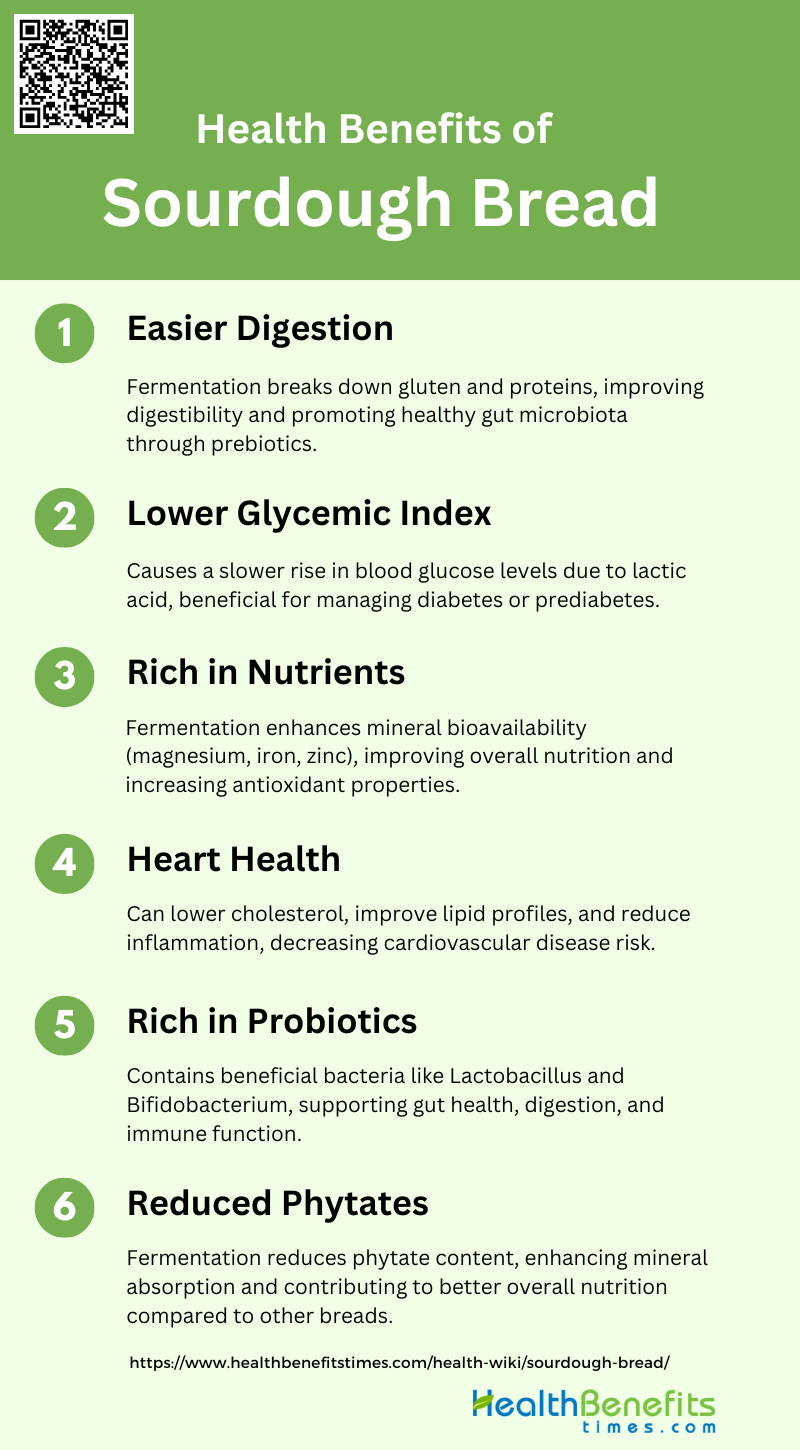Sourdough bread is a type of bread made through a long fermentation process using a sourdough starter, which is a mixture of flour and water that captures wild yeasts and lactic acid bacteria from the environment. This natural leavening agent gives sourdough its distinct tangy flavor and chewy texture. The fermentation process breaks down some of the starches and proteins in the flour, making the nutrients more bioavailable and potentially easier to digest for some people. Sourdough bread is often considered a healthier option compared to breads made with commercial yeasts, as it may have a lower glycemic index and contain beneficial compounds like antioxidants and prebiotics produced during fermentation. However, the health benefits can vary depending on the specific ingredients and fermentation conditions used.
Types of sourdough bread
This bread comes in a variety of types, each offering unique flavors and textures. From the classic tangy loaf to more specialized versions incorporating different grains and seeds, there’s a sourdough bread for every palate. Here are some popular types of sourdough bread:
1. Classic San Francisco Sourdough
Classic San Francisco Sourdough is renowned for its distinct tangy flavor, which is a result of the unique microflora, particularly Lactobacillus sanfranciscensis, involved in its fermentation process. This type of sourdough is characterized by a chewy crust and a soft, airy crumb. The fermentation process not only enhances the flavor but also improves the nutritional profile by increasing the bioavailability of minerals such as calcium, magnesium, and zinc. Studies have shown that San Francisco sourdough can lead to lower postprandial blood glucose and insulin responses, making it a healthier option compared to conventional breads.
2. Whole Wheat Sourdough
Whole Wheat Sourdough combines the benefits of whole grains with the unique properties of sourdough fermentation. This bread is rich in dietary fibers, vitamins, and minerals, which contribute to better digestive health and prolonged satiety. The fermentation process helps in breaking down phytic acid, thereby increasing the bioavailability of nutrients. Additionally, whole wheat sourdough has been shown to have a lower glycemic index compared to regular whole wheat bread, making it a suitable option for individuals managing blood sugar levels.
3. Rye Sourdough
Rye Sourdough is a dense, flavorful bread that is particularly popular in Northern and Eastern Europe. The use of rye flour, which has a lower gluten content compared to wheat, results in a denser texture. The sourdough fermentation process enhances the flavor and nutritional profile of the bread, making it rich in dietary fibers and essential nutrients. Rye sourdough has been found to have a positive impact on gut health due to its high content of fermentable fibers, which act as prebiotics.
4. Multigrain Sourdough
Multigrain Sourdough incorporates a variety of grains and seeds, such as oats, barley, flaxseeds, and sunflower seeds, into the dough. This combination not only enhances the flavor and texture but also boosts the nutritional value of the bread. Multigrain sourdough is rich in dietary fibers, proteins, and essential fatty acids. Studies have shown that consuming multigrain sourdough can lead to improved postprandial glucose and insulin responses, as well as reduced levels of inflammatory markers.
5. Spelt Sourdough
Spelt Sourdough is made from spelt flour, an ancient grain known for its nutty flavor and high nutritional value. Spelt is rich in proteins, dietary fibers, and essential minerals such as iron and magnesium. The sourdough fermentation process further enhances the digestibility and nutrient absorption of spelt bread. Research indicates that spelt sourdough can lead to lower postprandial blood glucose levels and improved gut health due to its high fiber content and prebiotic properties.
6. Seeded Sourdough
Seeded Sourdough is a type of sourdough bread that includes a variety of seeds such as chia, flax, pumpkin, and sesame seeds. These seeds add a crunchy texture and a rich, nutty flavor to the bread. They are also packed with essential nutrients, including omega-3 fatty acids, proteins, and dietary fibers. The fermentation process in seeded sourdough helps in breaking down the anti-nutrients present in seeds, thereby enhancing the bioavailability of these nutrients. This type of bread is particularly beneficial for heart health and digestive health.
7. Sourdough Baguette
This bread is characterized by its crispy crust and soft, airy crumb. The sourdough fermentation process not only enhances the flavor but also improves the shelf life and nutritional profile of the baguette. Sourdough baguettes have been found to have a lower glycemic index compared to regular baguettes, making them a healthier option for individuals managing blood sugar levels. Additionally, the fermentation process increases the bioavailability of essential minerals.
Health Benefits of Sourdough Bread
Sourdough bread offers several health benefits due to its unique fermentation process. Here are some key advantages:
1. Easier Digestion
This is primarily due to the fermentation process, which breaks down gluten and other proteins, making them easier for the body to process. The lactic acid bacteria (LAB) involved in sourdough fermentation produce enzymes that hydrolyze proteins and solubilize polysaccharides, improving the texture and digestibility of the bread. Additionally, the fermentation process can produce non-digestible polysaccharides that act as prebiotics, promoting a healthy gut microbiota.
2. Lower Glycemic Index
Sourdough bread has a lower glycemic index (GI) compared to bread made with baker’s yeast. This means it causes a slower and lower rise in blood glucose levels after consumption. The lactic acid produced during fermentation retards starch digestibility, leading to a lower glycemic response. Studies have shown that sourdough bread can significantly reduce postprandial glucose and insulin levels in individuals with impaired glucose tolerance, making it a beneficial option for those managing diabetes or prediabetes.
3. Rich in Nutrients
The process degrades phytates, which are compounds that inhibit mineral absorption, thereby increasing the availability of these essential nutrients. Research has demonstrated that sourdough bread can significantly improve the absorption of these minerals, contributing to better overall nutrition. Additionally, the fermentation process can increase the levels of bioactive compounds, such as phenolic compounds, which have antioxidant properties.
4. Heart Health
The dietary fiber and short-chain fatty acids (SCFA) produced during fermentation can reduce total cholesterol and triglycerides, as well as improve the ratio of low-density to high-density lipoprotein cholesterol. These changes are associated with a reduced risk of cardiovascular disease. Furthermore, the anti-inflammatory properties of sourdough bread, supported by the presence of beneficial gut bacteria like Akkermansia and Bifidobacterium, can also contribute to heart health.
5. Rich in Probiotics
The LAB strains found in sourdough starters, such as Lactobacillus and Bifidobacterium, are known for their probiotic properties. These bacteria can improve gastrointestinal health by enhancing the gut microbiota, aiding in digestion, and boosting the immune system. The presence of these probiotics in sourdough bread can help maintain a healthy balance of gut bacteria, which is crucial for overall health.
6. Reduced Phytates
The fermentation process in sourdough bread significantly reduces the phytate content, which can inhibit the absorption of important minerals. By breaking down phytates, sourdough fermentation enhances the bioavailability of minerals such as iron, zinc, and magnesium. This reduction in phytates not only improves mineral absorption but also contributes to better overall nutrition. Studies have shown that sourdough bread can lead to higher mineral absorption compared to other types of bread, making it a more nutritious option.
Nutritional advantages of sourdough
Here are some key nutrients and their benefits:
- Calories: Sourdough bread typically has a moderate calorie count, making it a good energy source without being overly caloric.
- Carbs: It provides complex carbohydrates, which are essential for energy.
- Fiber: The fermentation process can increase the fiber content, aiding in digestion and promoting a healthy gut.
- Protein: Sourdough contains a moderate amount of protein, which is important for muscle repair and growth.
- Fat: It is generally low in fat, making it a heart-healthy option.
- Selenium: This mineral acts as an antioxidant, helping to protect cells from damage.
- Folate: Essential for DNA synthesis and repair, folate is crucial for cell division and growth.
- Thiamine: Also known as Vitamin B1, thiamine helps convert carbohydrates into energy.
- Niacin: This B vitamin aids in metabolism and helps maintain healthy skin and nerves.
- Riboflavin: Also known as Vitamin B2, riboflavin is important for energy production and cellular function.
- Manganese: Essential for bone formation, blood clotting, and reducing inflammation.
- Iron: Important for the production of hemoglobin, which carries oxygen in the blood.
- Copper: Plays a role in iron metabolism and the formation of red blood cells.
How to make Sourdough Bread at Home
Making sourdough bread at home involves a few key steps, including preparing a sourdough starter, mixing the dough, fermenting, shaping, and baking. Here’s a simple guide:
1. Prepare the Starter: Feed your sourdough starter 4-6 hours before you plan to start baking. It should be bubbly and active.
2. Mix the Dough: In a large bowl, mix 500g of bread flour and 350g of water until no dry bits remain. Cover and let it rest for 30 minutes (autolyse). Add 100g of active sourdough starter and 10g of salt to the dough. Mix until well combined.
3. Bulk Fermentation: Cover the bowl and let the dough rest at room temperature for 4-6 hours. During this time, perform a series of stretch and folds every 30 minutes for the first 2 hours.
4. Shape the Dough: After bulk fermentation, turn the dough out onto a lightly floured surface. Shape it into a round or oval loaf. Place the shaped dough into a proofing basket or bowl lined with a floured cloth.
5. Final Proof: Cover the dough and let it proof for 2-4 hours at room temperature, or overnight in the refrigerator.
6. Preheat the Oven: Preheat your oven to 475°F (245°C) with a Dutch oven inside.
7. Bake the Bread: Carefully transfer the dough to the preheated Dutch oven. Score the top of the dough with a sharp knife. Cover with the lid and bake for 20 minutes. Remove the lid and bake for an additional 20-25 minutes, or until the crust is deep golden brown.
8. Cool the Bread: Let the bread cool on a wire rack for at least an hour before slicing.
Risks of sourdough bread
While sourdough bread offers numerous health benefits, there are some potential risks to be aware of:
1. Gluten Content
Sourdough bread, while often perceived as a healthier alternative to conventional bread, still contains gluten, which can pose risks to individuals with celiac disease or non-celiac gluten sensitivity. Research has shown that sourdough fermentation can reduce gluten content, but it does not eliminate it entirely. For instance, a study demonstrated that sourdough made with selected lactobacilli and nontoxic flours significantly reduced gluten levels, making it more tolerable for some celiac patients, but not completely safe for all. Therefore, individuals with severe gluten intolerance should exercise caution.
2. High Sodium
The fermentation process does not inherently reduce sodium content, and the amount of salt added during bread-making can vary. Some studies have explored the potential of sourdough fermentation to reduce the need for added salt while maintaining flavor and texture, but this is not a universal practice. High sodium intake is linked to increased blood pressure and other health issues, making it important for consumers to check the nutritional information of sourdough products.
3. Caloric Density
The fermentation process does not significantly alter the caloric content of the bread. While sourdough may have a lower glycemic index compared to other breads, which can be beneficial for blood sugar management, it still contains carbohydrates and calories that need to be accounted for in a balanced diet. Moderation is key to preventing excessive caloric intake from sourdough bread.
4. Allergies
Apart from gluten, sourdough bread can contain other allergens such as wheat, rye, or barley, depending on the flours used. Additionally, some individuals may be allergic to specific strains of yeast or bacteria used in the fermentation process. The presence of alpha-amylase/trypsin inhibitors (ATI) in wheat can also trigger immune responses in sensitive individuals, although sourdough fermentation has been shown to degrade these inhibitors to some extent. It is crucial for individuals with known food allergies to carefully read ingredient labels and consult with healthcare providers before consuming sourdough bread.
5. Digestive Issues
While sourdough bread is often touted for its potential digestive benefits, such as improved gut health and reduced symptoms of irritable bowel syndrome (IBS), it can still cause digestive issues in some people. The fermentation process produces organic acids and prebiotic compounds that can be beneficial, but it also generates gas and can lead to bloating or discomfort in sensitive individuals. Moreover, the presence of fermentable oligosaccharides, disaccharides, monosaccharides, and polyols (FODMAPs) in sourdough can exacerbate symptoms in those with IBS or other digestive disorders.





